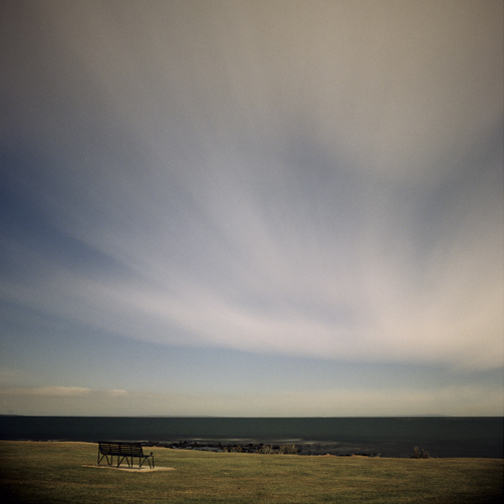
| Trace, 1997 |
| The Spirit of Photography |
| Sung, WanKyung, 1997 |
Photographs by Park, HongChun in the series Sea and Bench are touched by an unusual beauty of colors and poesie. They are beautiful ‘canvases’ in which the artist captures the breath of time in the vastness of sea and sky, caught with a long exposure of a tiny stream of light. Rather than being stopped by a release of the shutter, time is streamed out through the narrow diaphragm of the camera. One can feel the quiet breathing of the flow of eternal light. The photographs in this series were taken in Australia, on the seashores of Melbourne and Sydney. I use the word ‘taken’ but ‘made’ might be a better word, since every aesthetic effect appears to have been meticulously calculated before the release of the shutter. As is often said, drawing ‘encloses’ time, photography ‘stops’ time. With the accumulation of repeated gazes and gestures, drawing encloses the traces of time, but with the release of the shutter, the image is frozen at the moment chosen by the photographer. Delaying time to build up tiny brush strokes of light on the surface of photographic paper, Park, HongChun instills a profound spirit of poetics into his works. The accumulation of time in these photos are like the soft and delicate threads of silk wrapped around the silkworm, or misty cobwebs entangled around tree branches encountered on a morning walk, or the layers of thread on a spinning wheel. Mid-way, between ‘Empty’ and ‘Full’, Park, HongChun manages to capture the spirit of the picture and the picture of the spirit. The unusual, charged and well-measured chromatics and poetics of his works stem essentially from this spirit and from an eye possessing the talent of a painter able to gaze beyond the visible.
|
When we see a photo, we might ask whether the work is ‘an art of land’, depicting endless treasures of the visible or ‘an art of sea’ capturing invisible energies like those hidden beneath the sea’s surface. In this sense, Park, HongChun is an artist of the sea not only because the sea is a common subject in his works but for a more important reason. Pointing his lens towards the sea, Park captures its spirit but also succeeds in fusing the beauty of time and matter with an extraordinary sense of color and delicacy. The sea has long been a symbol of memory and time, and in literature, has alluded to the feminine since the time of the epics of Homer. Through his compositions of sea and sky, sometimes shown together with benches or paths, Park narrates a desire for roots, similar to his losing for his mother, now absent, but whose scent often surrounds him. Currently, the artist is exhibiting another series titled To Alice, in the Power section of the ’97 Kwangju Biennale.’ These photographs, taken in an artificial Disneyland-style amusement park visualize the ominous shadows of contemporary culture. The series, To Alice, stresses the colors of today’s cultural democracy and its consumerism through an aesthetics of the take, spectacles of excess and a surplus of juxtaposed spaces, while the Sea and Bench series evokes the grand Emptiness and broad horizons captured in the eyes of the soul. The source of his art lies in his extraordinary eye which sees beyond the visible to the spirit.
Originally published as: PARK HONG-CHUN, Seoul: Samtuh Art Books, 1997. Sung, WanKyung is an art critic and curator based in Seoul, and is currentely an honorary professor at InHa University. He was the commissioner (1995 and 1997) and the artistic director (2002) of the Gwangju Biennale.
|